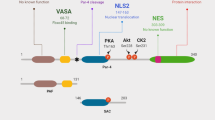Abstract
Evaluating the functional consequences of prostate apoptosis response gene-4 (par-4) expression in CD95-induced apoptosis of neoplastic lymphocytes, we demonstrate that par-4 increases apoptosis by upregulating the CD95 receptor on the cell surface and—with a concomitant decrease of the FLICE-like inhibitory protein (FLIP)—by promoting cleavage of the initiator caspases-8 and -10. This results in an enforced activation of the executioner caspases-6, -7, and -3 as well as in an activation of the mitochondrial pathway. Upon inhibition of caspase-8, overexpression of par-4 enables Jurkat cells to maintain a higher sensitivity to CD95-induced apoptosis by downregulating cIAP-2 and XIAP and by enforcing activation of the initiator caspase-10 as well as of the executioner caspases-6, -7, and -3.




Similar content being viewed by others
Abbreviations
- 7-AAD:
-
7-aminoactinomycin-D
- IAP:
-
Inhibitor of apoptosis protein
References
Bidere N, Lorenzo HK, Carmona S, Laforge M, Harper F, Dumont C, Senik A (2003) Cathepsin D triggers Bax activation, resulting in selective apoptosis-inducing factor (AIF) relocation in T lymphocytes entering the early commitment phase to apoptosis. J Biol Chem 278:31401–31411
Boehrer S, Chow KU, Puccetti E, Ruthardt M, Godzisard S, Krapohl A, Schneider B, Hoelzer D, Mitrou PS, Rangnekar VM, Weidmann E (2001) Deregulated expression of prostate apoptosis response gene-4 in less differentiated lymphocytes and inverse expressional patterns of par-4 and bcl-2 in acute lymphocytic leukemia. Hematol J 2:103–107
Boehrer S, Chow KU, Beske F, Kukoc-Zivojnov N, Puccetti E, Ruthardt M, Baum C, Rangnekar VM, Hoelzer D, Mitrou PS, Weidmann E (2002) In lymphatic cells par-4 sensitizes to apoptosis by down-regulating bcl-2 and promoting disruption of mitochondrial membrane potential and caspase activation. Cancer Res 62:1768–1775
Chen CY, Juo P, Liou JS, Li CQ, Yu Q, Blenis J, Faller DV (2001) The recruitment of Fas-associated death domain/caspase-8 in Ras-induced apoptosis. Cell Growth Differ 12:297–306
Cryns V, Yuan J (1998) Proteases to die for. Genes Dev 12:1551–1570
Deveraux QL, Roy N, Stennicke HR, Van Arsdale T, Zhou Q, Srinivasula SM, Alnemri ES, Salvesen GS, Reed JC (1998) IAPs block apoptotic events induced by caspase-8 and cytochrome c by direct inhibition of distinct caspases. EMBO J 17:2215–2223
Friesen C, Fulda S, Debatin KM (1997) Deficient activation of the CD95 (APO-1/Fas) system in drug-resistant cells. Leukemia 11:1833–1841
Herr I, Debatin KM (2001) Cellular stress response and apoptosis in cancer therapy. Blood 98:2603–2614
Huang DC, Strasser A (2000) BH3-only proteins-essential initiators of apoptotic cell death. Cell 103:839–842
Kataoka T, Budd RC, Holler N, Thome M, Martinon F, Irmler M, Burns K, Hahne M, Kennedy N, Kovacsovics M, Tschopp J (2000) The caspase-8 inhibitor FLIP promotes activation of NF-kappaB and Erk signaling pathways. Curr Biol 10:640–648
Krammer PH (2000) CD95’s deadly mission in the immune system. Nature 407:789–795
Qiu G, Ahmed M, Sells SF, Mohiuddin M, Weinstein MH, Rangnekar VM (1999) Mutually exclusive expression patterns of Bcl-2 and Par-4 in human prostate tumors consistent with down-regulation of Bcl-2 by Par-4. Oncogene 18:623–631
Scaffidi C, Fulda S, Srinivasan A, Friesen C, Li F, Tomaselli KJ, Debatin KM, Krammer PH, Peter ME (1998) Two CD95 (APO-1/Fas) signaling pathways. EMBO J 17:1675–1687
Scaffidi C, Schmitz I, Krammer PH, Peter ME (1999) The role of c-FLIP in modulation of CD95-induced apoptosis. J Biol Chem 274:1541–1548
Sprick MR, Rieser E, Stahl H, Grosse-Wilde A, Weigand MA, Walczak H (2002) Caspase-10 is recruited to and activated at the native TRAIL and CD95 death-inducing signaling complexes in a FADD-dependent manner but cannot functionally substitute caspase-8. EMBO J 21:4520–4530
Sun XM, Bratton SB, Butterworth M, MacFarlane M, Cohen GM (2002) Bcl-2 and Bcl-xL inhibit CD95-mediated apoptosis by preventing mitochondrial release of Smac/DIABLO and subsequent inactivation of X-linked inhibitor-of-apoptosis protein. J Biol Chem 277:11345–11351
Susin SA, Lorenzo HK, Zamzami N, Marzo I, Snow BE, Brothers GM, Mangion J, Jacotot E, Costantini P, Loeffler M, Larochette N, Goodlett DR, Aebersold R, Siderovski DP, Penninger JM, Kroemer G (1999) Molecular characterization of mitochondrial apoptosis-inducing factor. Nature 397:441–446
Van der Heiden MG, Thompson CB (1999) Bcl-2 proteins: regulators of apoptosis or of mitochondrial homeostasis? Nat Cell Biol I:209–216
Wang J, Chun HJ, Wong W, Spencer DM, Lenardo MJ (2001) Caspase-10 is an initiator caspase in death receptor signaling. Proc Natl Acad Sci U S A 98:13884–13888
Acknowledgments
Supported by a grant from the Deutsche Jose-Carreras-Leukämiestiftung and by the Johann Wolfgang Goethe-University in Frankfurt, Germany. The experiments comply with the current laws of the country inclusive of ethic approval.
Author information
Authors and Affiliations
Corresponding author
Rights and permissions
About this article
Cite this article
Bergmann, M., Kukoc-Zivojnov, N., Chow, K.U. et al. Prostate apoptosis response gene-4 sensitizes neoplastic lymphocytes to CD95-induced apoptosis. Ann Hematol 83, 646–653 (2004). https://doi.org/10.1007/s00277-004-0922-3
Received:
Accepted:
Published:
Issue Date:
DOI: https://doi.org/10.1007/s00277-004-0922-3




